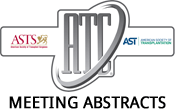2016 American Transplant Congress
Plasma Alemtuzumab Levels Show Great Interpatient Variability, but Are Not Associated with Late Acute Rejection in Simultaneous Pancreas-Kidney Recipients.
Introduction: Alemtuzumab induction followed by a steroid-free, tacrolimus (Tac) and mycophenolate mofetil (MMF) based regimen effectively prevented acute rejection after simultaneous pancreas-kidney transplantation (SPKT). Acute…2016 American Transplant Congress
Post-Transplant Reduction of Long Lived Plasma Cells from Peripheral Circulation Is Associated with Acute Rejection in Kidney Transplant Recipients.
Introduction:Plasma cells (PC) are usually defined functionally as antibody secreting cells (ASC). Depending upon their life span, they could either be short lived or long…2016 American Transplant Congress
Myeloid-Derived Suppressor Cells (MDSC) Accumulate in Intestinal Transplant (IT) Patients.
[Background] IT is an efficacious treatment for chronic intestinal failure. Recent advance of immunosuppressive regimens have decreased the rejection rate and improved patient survival. The…2016 American Transplant Congress
Assessment of Postoperative Glycemic Control in Orthotopic Heart Transplant Recipients.
NewYork-Presbyterian Hospital, Columbia University, New York.
Hyperglycemia may occur after solid organ transplantation because of stress, immunosuppressants, and diabetes mellitus. Glycemic control has been shown to decrease morbidity and mortality in…2016 American Transplant Congress
Inflammation Amplifier, a Chemokine Inducer in Non-Immune Cells in Kidney Transplantation Graft.
Introduction: Inflammation amplifier (IA), a local chemokine inducer in non-immune cells is induced by the simultaneous activation of NFκB and STATs (IL-17, TNFα, and IL-6)…2016 American Transplant Congress
Age Adapted Immunosuppression for Elderly Kidney Allograft Recipients: Balancing Risks for Cancer versus Rejection.
Introduction Cancer is a growing cause of morbidity and mortality after kidney transplantation, driven by immunosuppression. Age is one of the strongest risk factors for…2016 American Transplant Congress
Presence of Highly Immunogenic Mismatch Eplets Is Associated with Development of Chronic Active Antibody-Mediated Rejection: A First Report from Japan.
Urology, Hokkaido University Hospital, Sapporo, Hokkaido, Japan.
Backgrounds: De novo donor specific antibody (dnDSA) correlates with chronic active antibody-mediated rejection (CAAMR), a major leading cause of graft loss. It will be a…2016 American Transplant Congress
The Effect of Bortezomib on DSA Reduction During the Treatment of AMR in Pediatric Kidney Transplant Patients.
Medical University of South Carolina, Charleston, SC.
Introduction: The optimal therapy for AMR is not well defined in children or adults. AMR carries a worse prognosis than ACR and can lead to…2016 American Transplant Congress
A New Diagnostic Score for Microvascular Inflammation in Antibody-Mediated Rejection in Heart Transplantation.
BackgroundThe ISHLT working formulation defines Intravascular Activated Mononuclear Cells (IAMC) as one of the histopathologic features of antibody-mediated rejection (ABMR) in heart transplantation. However, no…2016 American Transplant Congress
Conditional Deletion of mTOR in Myeloid Cells Inhibits Chronic Allograft Rejection – A Novel Role for Macrophages in Transplant Vasculopathy.
Most transplants eventually lost to chronic rejection under potent immunosuppression therapies where activation of innate immunity is suspected to play a major role in graft…
- « Previous Page
- 1
- …
- 140
- 141
- 142
- 143
- 144
- …
- 172
- Next Page »
